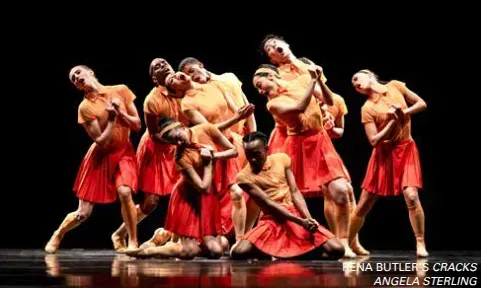Director’s Choice
Pacific Northwest Ballet
McCaw Hall, May 30, 2025
Opening nights in McCaw Hall are always fascinating, especially at the ballet. Its expansive lobbies fill up with early-comers who visit over a drink or poke around the wonderfully overstuffed gift shop. When the warning gong begins, the crowd flows toward their seats in a colorful parade.
In true Seattle style, patrons of ballet dress as though they are going to the movies, a wedding, a baseball game, a casino, or an opera — all of them happy and hopeful. Ballet seems to inspire a parallel artistic effort from the patrons: everything from tutus on little girls and adults in native dress (muumuus, aloha shirts, kimonos, barongs) to fabulous vintage and designer clothes when the big donors file in from the opening night gala. Yet this preshow spectacle is only a prelude to the fabulous dancing to come.
On May 30, the PNB presented three fascinating pieces chosen by the director Peter Boal, now one of the leading promoters of new works in the ballet world today. Over his 20 years of leading the PNB into the spotlight of great dance companies, Boal has sponsored new and emerging choreographers such as Justin Peck, Nacho Duato, and Alejandro Cerrudo. He has also had an important interest in supporting women choreographers such as Annabelle Lopez Ochoa, Crystal Pite, and Robyn Mineko Williams, as well as the PNB’s own dancers who are becoming gifted choreographers: Price Suddarth, Paul Gibson, and Kyle Davis.
Now, with the 2025 Director’s Choice program, Boal has continued this important process by choosing Rena Butler and Kiyon Ross to join the super established Twyla Tharp in this year’s terrific showcase.
…throes of increasing wonder
Choreography: Kiyon Ross
Music: Cristina Spinei
Lighting design: Reed Nakayama
Costume design: Pauline Smith
Scenic design: Norbert Herriges and Reed Nakayama
On this marvelous evening of dance, the happiest offering came first: a creation from Kiyon Ross that matched the high spirits of the audience and showcased everything delightful about the geometry of ballet.
Ross, a former PNB dancer, knows from his own experience how to bring together music, movement, and dancers at their most glorious — and how to enable the audience to experience that glory through visual and auditory senses of delight. The title of this terrific work, first commissioned for the PNB’s 50th anniversary in 2023, is a perfect description of how people feel as they watch it.
Along with a lively score by composer Cristina Spinei, the audience was treated to wave after wave of 24 dancers flying through the air, spinning, leaping, and forming patterns with their arms and legs like an ever-expanding constellation of stars. It was so beautiful and so fast that attendees could barely register one movement sequence before the next began.
Pauline Smith’s costumes of white, fluttering skirts over layers of blue, red, and turquoise made the women sparkle among the men in their simple white leotards. Groups as small as two, three, or four and as just as lavish alternated with (as promised) increasing wonder until it felt like the dance version of a beautiful kaleidoscope.
While I’m sure Ross has the full complement of tones and styles in his vocabulary, I was delighted to see what he does when he’s in the throes of wonder — and takes his audiences there too.
Cracks (2025 World Premiere)
Choreography: Rena Butler
Music: The Tudor Choir singing works of Michel Wackenheim, Gabriel Fauré, Antonio Vivaldi, Ljova, Francis Poulenc, Claude Debussy, and Michael Praetorius
Costume design: Meleta Buckstaff
Lighting design: Julie Ballard
Cracks is a fascinating world premiere by Rena Butler that poses serious questions about religious education, with a potent combination of elegant music, colorful unisex uniforms , and quirky, inventive choreography.
Eleven dancers portray anxious youngsters who hunch and shuffle in a phalanx of worried obedience. Wearing Meleta Buckstaff’s clever unisex uniforms, they tumble and slink around as if to avoid bolts from heaven. Their scaredy-cat gestures begin humorously (many of us religious school kids remember that shrinking feeling) but grow more dramatic as cracking sounds begin to interrupt the classical strains of early music. What begins as familiar and funny becomes ominous as Butler asks the question she proposes in the program notes: “…whether or not fervent worship or adherence leads to one’s true evolutionary journey to the higher self.”
Like Ross, Butler is a brilliant dancer in her own right, and has moved to choreography with great power and wit. Cracks was 99% perfect in my view — I only wish the sound of the cracks that interrupted a wonderful catalogue of classical music had made sense from the beginning. If I hadn’t read the program, I wouldn’t have understood what they were. Nevertheless, I could never get enough of her wonderful choreography, and I look forward to following her brilliant career.
Nine Sinatra Songs (1982)
Choreography: Twyla Tharp
Original costume design: Oscar de la Renta
Original scenic design: Santo Loquasto
This nostalgic offering was last on the bill and a great hit with the audience, who gave it a standing ovation — especially the women dancers, who had to navigate the midcentury music in high heels. Kudos for the very brave and talented Angelica Generosa, Sarah-Gabrielle Ryan, Lily Wills, Madison Rayn Abeo, Elizabeth Murphy, Juliet Prine, and Clara Ruf Maldonato — all of them beautiful, elegant, and witty. The men were equally cool and looked sharp in their formal wear, but in this return to an earlier ethos, they didn’t come across as more than elegant, and in some cases less than gentlemanly.
But what else could they do, given the male-centric themes that Frank Sinatra valorized, which many people find problematic now? Sinatra became the voice of doing things “my way” no matter the cost, using and losing women as it suited him, as well as exerting his singular manly power and authority. (Sound like someone we know?)
Full disclosure: I’m a feminist, but unless this dance is seen as an ironic comment on the masculinized past — which the dancers were able to convey in a humorous way — I suspect that Sinatra and his chest-thumping masculinity is more a reflection on our current political problems than a positive look at the past.
My vote is for PNB to continue promoting new choreographers like Ross and Butler, whose thoughtful, complex, and fascinating work brings fresh delights and new insights into the dance scene. I also cast my vote — as a personal sidebar, since I’ve just returned from Paris, where I saw Manuel Legris’ Sylvia at the Palais Garnier — that some of the less frequently seen classics like Sylvia would lend some interesting context to the wonderful modernity of PNB.
The Pacific Northwest Ballet presents “Director’s Choice” at McCaw Hall through June 8, 2025. Go to https://www.pnb.org for tickets and information.
Support the Seattle Gay News: Celebrate 51 Years with Us!
As the third-oldest LGBTQIA+ newspaper in the United States, the Seattle Gay News (SGN) has been a vital independent source of news and entertainment for Seattle and the Pacific Northwest since 1974.
As we celebrate our 51st year, we need your support to continue our mission.
A monthly contribution will ensure that SGN remains a beacon of truth and a virtual gathering place for community dialogue.
Help us keep printing and providing a platform for LGBTQIA+ voices.
How you can donate!
Using this link: givebutter.com/6lZnDB
Text “SGN” to 53-555
Or Scan the QR code below!



